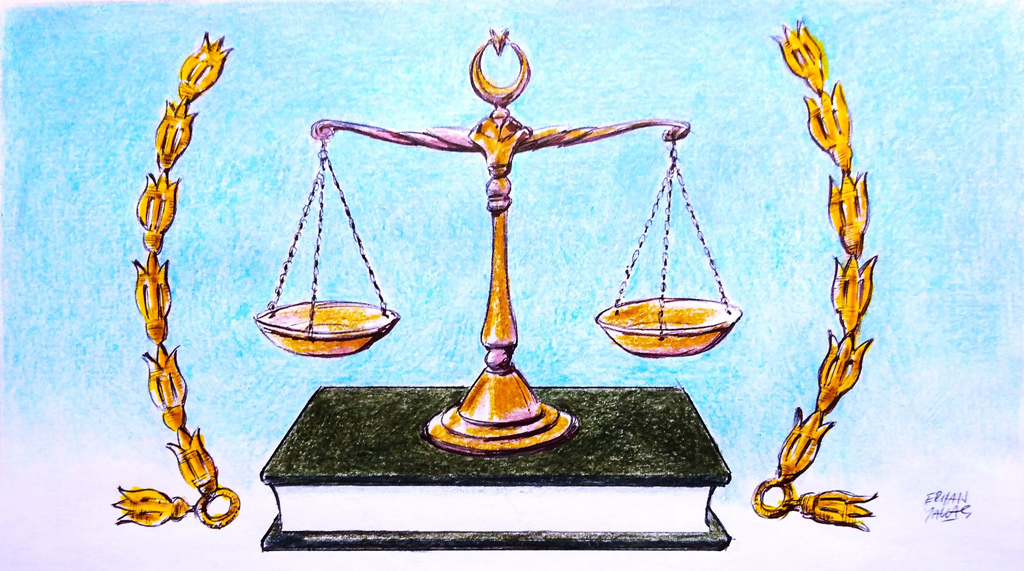Türkiye has a long history of judicial and legal reforms, dating back to the 19th century. This transformation has been influenced by various factors throughout history. The primary motivation for reshaping the judiciary and legal framework was the push for Westernization during the Ottoman era.
In the classical period, Ottoman law was primarily based on two sources: Islamic law (sharia) and customary law – more precisely, imperial law. However, during the Tanzimat ("Reform") period, the Empire adopted various legal codes, including commercial law and civil and criminal procedural codes, many of which were adapted from French law.
As part of this legal transformation, the first Ottoman-Turkish Constitution was enacted in 1876, drawing significant influence from the Belgian Constitution of 1831 and the Prussian Constitution of 1850. While legal modernization continued, local regulations remained in force, creating a dual legal structure.
Following the establishment of the republic in 1923, a radical shift occurred. The founders of modern Türkiye intensified legal modernization efforts, leading to the complete secularization of the legal system.
However, significant problems persisted in other key areas, such as judicial impartiality and independence, the right to a fair trial and alignment with constitutional democracy. While the Turkish judiciary burdened citizens with endless lawsuits, it also functioned as a key tutelary institution, exerting control over Turkish democracy.
Despite liberalization efforts and Türkiye’s pursuit of European Union membership in the 1980s and 1990s, meaningful solutions to the judiciary’s structural problems never materialized. The primary reason for this was a lack of political will, as comprehensive reforms require stable political backing. Türkiye experienced persistent political and economic turmoil during this period, with governments lasting an average of just 11 months.
Plan-based reforms
The Justice and Development Party's (AK Party) rise to power in late 2002 marked a turning point in Türkiye’s judicial transformation, as well as in its economic, political and social landscape. Initially, the AK Party prioritized aligning Turkish law with the EU acquis, enacting numerous regulations primarily anchored in EU standards. This era, which focused on reforms to strengthen rights and freedoms, the rule of law and democratization, was referred to as a “silent revolution.”
In 2009, Türkiye adopted a more structured approach to legal and judicial reform with the introduction of the Judicial Reform Strategy Document, marking the beginning of systematic, plan-based reforms in the judiciary. This document was updated twice, in 2015 and 2019. These strategy documents provided a holistic perspective and roadmap for reform, helping address long-standing issues within the judiciary. They covered not only judicial processes but also human rights issues.
Key developments under previous reform strategies can be summarized as follows: military courts were gradually abolished, leading to the civilianization of the judiciary; several national mechanisms for the protection of human rights were established; a three-instance judicial system was introduced with the establishment of the Court of Appeals, aimed at reducing the workload of the Court of Cassation and the Council of State; target timeframes for judicial procedures were implemented to prevent delays; alternative dispute resolution methods, such as mediation in civil cases and conciliation in criminal proceedings were introduced; the number of judges, prosecutors and auxiliary personnel working in justice services substantially increased. Approximately 75% of the activities planned in the third strategy document (2019-2023) were implemented.
4th judicial reform
With the third judicial reform strategy concluding in 2023, expectations were high for a new roadmap to continue Türkiye’s legal transformation. On Jan. 23, 2025, President Recep Tayyip Erdoğan unveiled the Fourth Judicial Reform Strategy. This new strategy highlights the Erdogan government’s continued commitment to reform, even after 22 years in power.
The new strategy document outlines five aims, 45 objectives and 264 activities. It also states that “a clear and measurable Action Plan will be prepared following the publication of the document,” mirroring the approach taken in the 2019 strategy.
The strategy focuses on three key priorities: expediting and simplifying judicial processes, enhancing the efficiency of the criminal justice system, and improving the quality of human resources.
On the one hand, the government seeks to meet citizens’ expectations for quicker and more accessible legal procedures. On the other hand, it aims to enhance the investment climate by fostering a predictable and stable legal system. To achieve this, the document emphasizes concrete, actionable activities.
Furthermore, the strategy places significant emphasis on strengthening the impartiality and independence of the judiciary, an essential foundation for any constitutional democracy.
Strengthening independence
Judicial independence is a cornerstone of any justice system committed to upholding the rule of law. To this end, the new strategy introduces a crucial reform: the guarantee of location. This principle ensures that judges and public prosecutors can serve in their courts without fear of transfer, except under objective and transparent conditions.
If successfully implemented, this reform could mark a milestone for judicial independence in Türkiye, reinforcing public trust in the legal system.
One of the most persistent issues within the Turkish judiciary has been its sluggish pace and lengthy trial periods. Although several measures–such as setting target timeframes and increasing the number of judges and courts- have been introduced to address this, the new strategy brings further innovations.
The strategy stipulates that cases before the Supreme Courts and Courts of Appeal must be resolved within six months. Additionally, trial delays are capped at a maximum of two months in exceptional circumstances.
Efficient judicial system
In addition to expanding the judiciary’s size, enhancing the quality of its human resources has been a central focus of the last two strategy documents. The government has adopted a comprehensive, three-pillar approach to achieve this objective: A new entrance exam for legal professions was implemented as a prerequisite for all legal careers; a significant change is the introduction of a judge and prosecutor assistantship as an entry-level position prior to appointment as a judge or prosecutor; and lastly, in-service training has become a key criterion for the promotion of judges and prosecutors.
The new strategy document introduces additional activities aimed at improving human resources in the judiciary including the following: Revising the criteria for establishing law schools to ensure higher educational standards; increasing the selectivity of the judge and prosecutor assistantship exam by incorporating both written and oral components to attract top-tier candidates; and enhancing the specialization of judges in both civil and criminal law to improve judicial expertise and decision-making quality.
Finally, the document aims to establish a criminal justice system that balances deterrence with rehabilitation. However, reforms in the criminal justice system warrant a separate discussion.
In essence, the new reform strategy aims to establish a predictable and efficient judicial system. By doing so, the government seeks to build public confidence in the judiciary and create a favorable environment for economic development. While the document is not legally binding, it serves as a roadmap for the government. The government’s stable majority in Parliament is a key advantage, as many activities outlined in the document will require legislative amendments. Indeed, the objectives of the previous strategy were successfully implemented with strong parliamentary support.
While the document includes important objectives for strengthening judicial independence, the most effective reforms in this field can only be realized through a new constitution that prioritizes mechanisms of checks and balances. As a result, this document demonstrates that Türkiye maintains its commitment to legal and human rights reforms despite regional and global instability.






